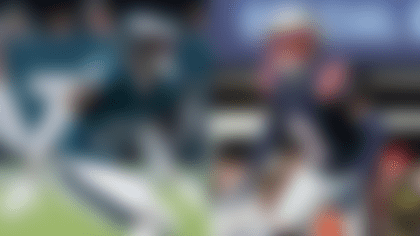In an increasingly pass-happy NFL, coverage defenders have never been more important. If the pass rush doesn't get home, the onus falls on the players on the back end to deny opposing quarterbacks' attempts to move the ball through the air.
Top cornerbacks are among the highest-paid defenders in the league, and rightfully so. But who is the best in coverage? We can find out with the help of Next Gen Stats. Here are some important notes about the parameters I used to separate the best coverage defenders from the rest ...
In order to qualify, players needed a minimum of 300 coverage snaps, 40 targets as the nearest defender and a catch rate allowed below expectation (meaning they're consistently breaking up passes that were likely to be completions). Also, qualifiers had to have a negative targeted expected points added (a metric used to quantify how much an individual player impacts an opponents' scoring potential and the most important metric used in this exercise), a tight-window percentage of at least 20 (15 for linebackers, due to the nature of their position as second-level run defenders and coverage defenders) and a maximum passer rating allowed of 80.
Now, this isn't a perfect examination. While Next Gen Stats provides an unparalleled amount of information thanks to tracking technology implemented on NFL fields, it doesn't have eyes. NGS can't assign responsibility for coverage, so the next-best quantification comes by measuring tracking data for the defender nearest to the targeted pass catcher.
With this in mind, I'm judging the numbers produced by NGS with a focus on how tightly defenders covered targeted pass catchers. Essentially, who blanketed opposing weapons most effectively and consistently?
Although linebackers and safeties occasionally sneak into the top 10, this list will always -- unsurprisingly -- be dominated by cornerbacks.
Let's dive into the results.
JUST MISSED: Cameron Sutton, CB, Detroit Lions (Steelers in '22); D.J. Reed, CB, New York Jets; Tyrann Mathieu, S, New Orleans Saints; Kevin Byard, S, Tennessee Titans; Juan Thornhill, S, Cleveland Browns (Chiefs in '22); Alex Anzalone, LB, Detroit Lions.
- Passer rating allowed: 75.4
- Catch rate allowed below expectation: -8.2%
- Tight-window percentage: 26.7%
- Target rate: 22.1%
- Average separation: 2.7 yards
- TARGETED EXPECTED POINTS ADDED: -10
This was almost Patrick Peterson’s spot, but he fell short of the required tight-window rate of 20 percent (17.7%).
Much of Davis’ standing here was built on his ability to make plays on the ball. His 12 passes defensed and one interception produced a ballhawk rate of 13.3 percent, helping his targeted EPA finish at -10. (Ballhawk rate measures how often someone makes a play on the ball, via pass defensed or interception.) He was incredibly effective in man coverage, finishing with the second-best targeted EPA in the entire league (min. 20 such targets) in man at -23.4 and recording eight of his 12 passes defensed in the coverage.
He was significantly worse in zone coverage, bringing his combined totals down to a level that just barely gets him into the top 10. It’s still excellent company, and a sign that perhaps the Buccaneers would be better suited to rely more on man in 2023 than they did a year ago. Davis would benefit, at least.
- Passer rating allowed: 70.8
- Catch rate allowed below expectation: -12.2%
- Tight-window percentage: 26.5%
- Target rate: 17%
- Average separation: 3 yards
- TARGETED EXPECTED POINTS ADDED: -11.7
There’s only one true explanation for why Williams didn’t land higher on this list, which is ordered by targeted EPA: Opposing defenses likely didn’t test him on high-value passes.
Williams’ numbers are strange in that he allowed one of the best catch rates below expected at -12.2 percent, posted a tight-window rate of 26.5 percent and recorded 16 passes defensed, yet finished with a targeted EPA of just -11.7 despite surrendering only one touchdown as the nearest defender. It seems like his targeted EPA should be better -- unless he just didn’t see targets on passes that could have produced greater outcomes for opposing offenses.
Williams’ catch rate allowed below expectation was the second-best of any player in this top 10, trailing only Philadelphia’s James Bradberry. He had a very solid season, especially in man coverage, recording nine passes defensed and a targeted EPA of -9.4. At 5-foot-9, he just didn’t produce enough interceptions -- he's actually gone pick-less in each of the past two seasons after nabbing four in 2020 -- to boost his targeted EPA into an elite range.
- Passer rating allowed: 76.2
- Catch rate allowed below expectation: -7.4%
- Tight-window percentage: 25.5%
- Target rate: 15.1%
- Average separation: 2.7 yards
- TARGETED EXPECTED POINTS ADDED: -12.9
Fulton only appeared in 11 games in 2022, but he saw enough action to qualify for this list and emerge as one of the top 10 coverage defenders.
A catch rate allowed below expectation of -7.4 percent is the fifth-best mark in the category among players on this list. His tight-window rate of 25.5 percent helped him record five passes defensed and one interception on 55 targets. Those totals aren’t exactly remarkable, but defenders are often most effective by making plays that don’t show up in these categories. We can find that detail in his coverage success rate (the percentage of targets that result in a successful play for the defense). He had the second-best rate among players in this top 10 at 65.5 percent.
It’s interesting to consider what Fulton’s numbers might have looked like had he avoided a nagging hamstring issue and stayed on the field more. A higher volume might have helped him post greater totals in passes defensed and interceptions. Ultimately, his success rate and tight-window rate tell us the true story: Fulton likely would have continued to find success over a full season, if given the chance.
- Passer rating allowed: 65
- Catch rate allowed below expectation: -6.8%
- Tight-window percentage: 20.7%
- Target rate: 18.5%
- Average separation: 2.8 yards
- TARGETED EXPECTED POINTS ADDED: -15.6
Although Jones will turn 30 early in the 2023 season, New England was wise to retain him on a two-year deal this offseason. Also, the Patriots were smart to pair him with their first-round pick, Christian Gonzalez, who could learn a lot from the former undrafted free agent.
A Patriots defensive back is appearing on this list for the second year in a row. Last year, it was the since-departed J.C. Jackson (now with the Chargers) who ended up at No. 2. This time around, it’s Jones coming in at No. 7 thanks to a -15.6 targeted EPA that came as a result of his four interceptions and 11 passes defensed. Jones allowed a reception on 50 percent of targets as the nearest defender, but with a success rate of 63.4 percent, he managed to limit opposing passers to one of the lowest ratings in the NFL at 65.
Jones isn't quite in the elite category, but he leads the next tier of defenders on this list with the second-most interceptions of any player in the top 10.
- Passer rating allowed: 66.4
- Catch rate allowed below expectation: -1.7%
- Tight-window percentage: 29.1%
- Target rate: 20.1%
- Average separation: 2.6 yards
- TARGETED EXPECTED POINTS ADDED: -19.9
Alexander’s two second-team All-Pro nods and Pro Bowl selections confirm what we already know about him: He’s a top-tier cornerback who thrives when asked to match opposing pass catchers step for step. Alexander owns the second-highest tight-window rate in the NFL since 2018 (33.3%) and he posted the 11th-best ballhawk rate in man coverage (24%) among all defenders (minimum 20 targets in man coverage) in 2022. In those situations, he forced a tight window on 44 percent of his 25 targets and recorded six passes defensed.
Alexander saw one of the highest target rates of any defender on this list, yet he consistently produced, posting a ballhawk rate of 17.7 percent thanks to 14 passes defensed and five interceptions (the top total on this list) on 79 targets. Those numbers also propped up his targeted EPA, which finished sixth among all qualifying defenders, and his passer rating allowed of 66.4 was the fourth best among those defenders.
- Passer rating allowed: 72.9
- Catch rate allowed below expectation: -4.3%
- Tight-window percentage: 27.7%
- Target rate: 15.4%
- Average separation: 3 yards
- TARGETED EXPECTED POINTS ADDED: -21.3
Our first and only safety of the top 10 lands at No. 5. It's traditionally more difficult for safeties to grace this list because of a lack of total targets as the nearest defender, given the nature of the position, and their numbers usually reflect this disparity. Neal, however, made the cut in part because he spent a good amount of the 2022 season in Seattle playing closer to the line of scrimmage than a typical safety.
Neal was remarkably effective when challenged by opposing quarterbacks, posting the best coverage success rate of all safeties in 2022 at 74.5 percent -- a massive jump from his 42.3 mark in 2021. The Week 1 loss of Jamal Adams undoubtedly contributed to Neal's increased usage, but instead of wilting, the former undrafted free agent out of Southern Illinois rose to the occasion, leading to a new contract with the Buccaneers in April.
Because of his success in coverage, Neal's targeted EPA finished in the top five among all qualifying defenders, even with only one interception to his name in 2022. The Bucs got him at a bargain price, and will hope he produces similarly in his first season in Tampa.
- Passer rating allowed: 75.9
- Catch rate allowed below expectation: -1.7%
- Tight-window percentage: 32.9%
- Target rate: 14.1%
- Average separation: 2.3 yards
- TARGETED EXPECTED POINTS ADDED: -23.1
Campbell ended up being responsible for six touchdowns as the nearest targeted defender, which would typically tank a player's targeted EPA. That wasn't the case for this cover man because of how often he disrupted other pass attempts.
Campbell finished with the fifth-highest ballhawk rate of any player in this top 10 at 19 percent, a number carried by his 15 passes defensed. Only three other players in this group outperformed Campbell in passes defensed. Campbell's numbers weren't quite as stellar across the board, but he also saw the lowest amount of attention in terms of target rate among any of these players at 14.1 percent, meaning Campbell consistently made an impact even when he didn't see as many coverage opportunities as others.
In short, Campbell did a very good job despite tying for the third-fewest targets of any player on this list (and the second-fewest among cornerbacks on this list). And as you've already discovered, he isn't the only Jaguar to make this top 10, either. That Jacksonville defense was better than most likely remember, thanks to the performance of players like Campbell.
- Passer rating allowed: 78.7
- Catch rate allowed below expectation: -6.4%
- Tight-window percentage: 27.5%
- Target rate: 21.9%
- Average separation: 2.9 yards
- TARGETED EXPECTED POINTS ADDED: -25
Kohou's story is something out of a Hollywood script. The Texas A&M-Commerce standout made the leap from NCAA Division II to the NFL as an undrafted free agent in 2022 and worked his way onto the final 53-man roster, where he quickly enjoyed a spike in playing time in the regular season.
Whatever Miami saw in Kohou was clearly prescient. The unlikely contributor quickly blossomed into a very reliable and productive slot corner for the Dolphins in his first season, finishing with the fourth-lowest targeted EPA (-10.1) among all slot corners when playing zone coverage. In all coverage scenarios, Kohou was remarkably effective, staying in the hip pocket of intended targets often enough to post a tight-window percentage near 28. He ends up so high on this list because of his overall targeted EPA (-25), which was the third-best mark of any defender in the league despite his accompanying ballhawk rate of just 9.8 percent.
- Passer rating allowed: 62.9
- Catch rate allowed below expectation: -8.4%
- Tight-window percentage: 30.9%
- Target rate: 15.7%
- Average separation: 2.5 yards
- TARGETED EXPECTED POINTS ADDED: -28.8
The Defensive Rookie of the Year ballot was little more than a formality by the time the regular season ended, and if anyone thinks Sauce earned that honor based on nickname notoriety, these numbers stand as proof that Gardner is much more than just hype (and a sweet wing sauce deal). Gardner embodied the shutdown corner moniker in 2022, blanketing opposing pass catchers at an elite rate and denying scoring opportunities at a premier level in his debut NFL season.
Gardner's NFL-high 20 passes defensed and two interceptions made for one of the top ballhawk rates in the entire league (24.7%), and opposing offenses who deemed it advantageous to attack a rookie soon learned they'd made a grave mistake. Of 81 targets as the nearest defender, Gardner allowed just 39 receptions. His coverage success rate was excellent.
Opposing quarterbacks know one thing heading into the 2023 season: Throwing in Sauce's direction isn't the wisest decision.
- Passer rating allowed: 54.7
- Catch rate allowed below expectation: -12.5%
- Tight-window percentage: 29.4%
- Target rate: 16.1%
- Average separation: 2.3 yards
- TARGETED EXPECTED POINTS ADDED: -32.8
A lot of these players were remarkably close in final numbers. Bradberry, on the other hand, stood apart from the rest. His overall totals didn't quite reach the level of Atlanta's A.J. Terrell in 2021 (although he surpassed Terrell in targeted EPA), but he was clearly the NFL's best coverage defender as the nearest targeted in 2022.
Opposing passers found it incredibly difficult when throwing Bradberry's way, posting a combined passer rating of 54.7, easily the lowest among all qualifying defenders (the only mark below 60, in fact). Bradberry finished with a respectable-but-not-remarkable three interceptions (while allowing three touchdowns), but his consistency when it came to denying pass attempts elevated his targeted EPA to the best mark in the league.
Sure, it helps to play opposite Darius Slay, and it certainly didn't hurt that he was sharing the field with the league's top sack defense. But Bradberry proved exactly why the Eagles jumped at the opportunity to add him after he became a cap casualty of the rival Giants last May: He's a premier cover man who can help elevate a defense to the status of title contender.
Follow Nick Shook on Twitter.






















